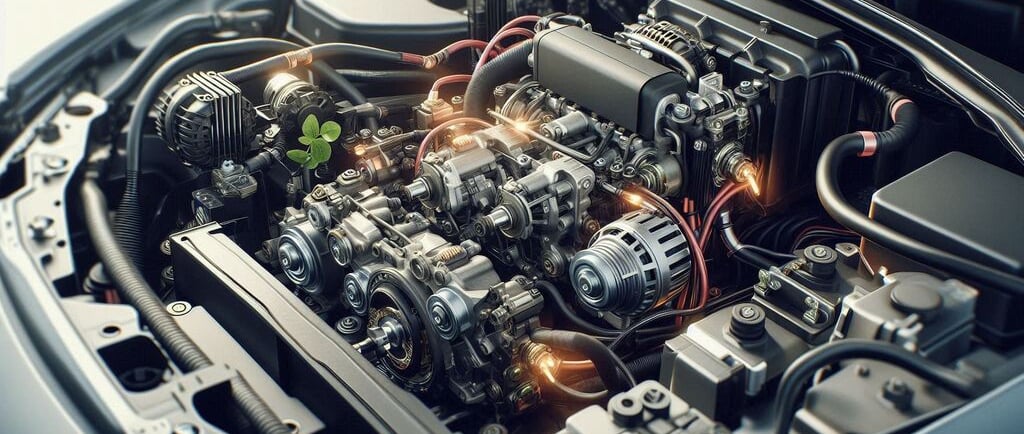Starters
Imagine getting ready for your morning commute, only to find your car won’t start. This common scenario often points to an issue with the car’s starter.
ELECTRICAL SYSTEMS
11/14/20244 min read


Everything You Need to Know About Car Starters: How They Work, Troubleshooting, and Maintenance Tips
Imagine getting ready for your morning commute, only to find your car won’t start. This common scenario often points to an issue with the car’s starter. A car starter plays a vital role in getting your engine running smoothly, and knowing how it works can help you spot potential issues before they turn into major headaches. This guide covers everything from how starters work to troubleshooting and maintenance tips to keep your vehicle in top shape.
What is a Car Starter?
A car starter is an electric motor responsible for cranking the engine and initiating the internal combustion process. This small but powerful motor is essential because, without it, the engine cannot start. The starter motor works together with the car’s battery and ignition system to get the engine running.
Key Functions of a Car Starter
Engine Cranking: The starter motor turns the engine's crankshaft, which initiates the combustion process.
Ignition Engagement: The starter solenoid, a small coil, closes the electrical circuit between the battery and the starter, allowing power to flow to the starter motor.
How Does a Car Starter Work?
The starter operates in a relatively simple yet effective way. When you turn your car key or press the ignition button, the battery sends an electrical signal to the starter motor. This signal activates the starter solenoid, which bridges the electrical circuit between the battery and the motor. The starter motor then spins the engine’s flywheel, turning the crankshaft and beginning the combustion process. Once the engine starts running, the starter disengages to avoid damaging the motor.
Key Components of a Starter System
Starter Motor: The main motor responsible for turning the engine over.
Starter Solenoid: An electromagnetic switch that connects the battery to the starter motor.
Flywheel and Pinion Gear: The flywheel helps the engine turn over, while the pinion gear on the starter motor engages with the flywheel to initiate rotation.
Common Signs of a Failing Starter
Car starters are built to last, but they can wear out over time. Recognizing the signs of a failing starter early can save you from inconvenient breakdowns. Here are a few common symptoms to watch out for:
1. Clicking Noise When Turning the Key
A common sign of a failing starter is a clicking sound when you turn the key or press the ignition button. This clicking usually indicates that the starter solenoid is not getting enough power from the battery to engage the motor.
2. Slow Engine Crank
If your engine cranks more slowly than usual, it could be due to a worn-out starter motor or a weak battery. Slow cranking often indicates that the starter is struggling to turn the engine.
3. No Response at Ignition
When you turn the key and hear nothing, it might be a problem with the starter solenoid or an electrical connection issue. Sometimes, the car may also have intermittent starting issues, meaning the starter works only occasionally.
4. Smoke from the Engine Bay
Overheating can cause the starter motor to emit smoke. If you notice a burning smell or smoke coming from under the hood, the starter may have shorted out due to excessive heat, which could indicate an underlying issue with the starter or another part of the electrical system.
Diagnosing Starter Problems
Starter issues can sometimes be confused with other engine or battery problems. Here are some steps you can take to diagnose whether the issue lies with your starter:
1. Check the Battery
Sometimes, a dead battery mimics starter issues. Use a multimeter to check the battery’s voltage; a fully charged battery should read around 12.6 volts. If the battery is low, try jump-starting the car to see if it resolves the issue.
2. Listen for Unusual Sounds
Clicking or grinding noises when starting your car can help identify if the problem is with the starter or another component. Grinding noises, for example, might suggest that the pinion gear is failing to engage properly with the flywheel.
3. Inspect Electrical Connections
Loose or corroded connections between the battery, starter motor, and solenoid can disrupt power flow, preventing the starter from working. Check and clean the battery terminals and starter connections to ensure they are tight and corrosion-free.
Maintaining Your Car Starter for Longer Life
With a few maintenance steps, you can help prolong the life of your starter and reduce the likelihood of unexpected issues.
1. Regular Battery Maintenance
Since the starter relies on battery power, keeping the battery in good condition is essential. Check the battery’s voltage regularly and ensure it’s fully charged, especially in cold weather.
2. Avoid Frequent Short Trips
Short trips don’t allow the battery to recharge fully, which can drain it over time and put additional strain on the starter. Whenever possible, take longer drives to help keep the battery charged and reduce strain on the starter.
3. Limit Accessory Use Before Starting
Using accessories (like the radio or air conditioning) before the engine starts can drain the battery and impact the starter's performance. It’s best to avoid running these until the engine is fully running.
4. Keep Connections Clean
Dirt and grime can build up on electrical connections over time. Cleaning battery and starter connections can help maintain proper current flow, reducing wear on the starter.
Replacing a Faulty Starter
If you experience consistent starting issues and have ruled out battery problems, it may be time to replace the starter. While some car owners may feel comfortable replacing a starter themselves, it’s often best to have a professional mechanic handle it due to the complexity and location of the starter in most vehicles.
Replacement costs for a starter can vary, depending on the make and model of your car. In general, expect to pay between $200 and $500 for parts and labor combined, though this can vary based on your location and vehicle type.



